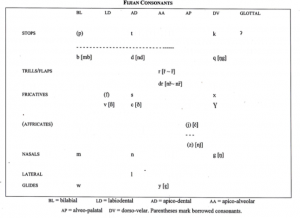I have spent days working on Buan language; it’s not the vocabulary but the crafting of phrases, the phonology and orthography. I applied the measure units after translating from the Swadesh 100 word list that covers body parts, animals, metal objects and phenomena and adjectives. This was then following by recording the Buan words for the important phonetics and phonology that focus on sound. The sound system in Buan had both the Cyrillic and Latin alphabet that was exciting to note since the standard Fijian language had only Latin alphabet. For instance the Cyrillic letter used in the following words are “ ℽarua, ℽena, vateℽeva and roℽa”. Buan working orthography uses the “gato” also known as the Hawaiian ‘okina while the standard Fijian has no gato. Examples of the Buan gato words are ‘ani, ‘ei’ei, ‘abani and varai’aℽi.
Phonemic Contrasts
| Word 1 | Translation | Word 2 | Translation | Sounds that contrast |
| toko | stick for planting | moko | lizard | t, m |
| buku | buttocks | kuku | nail | b, k |
| xalo | swim | talo | taro | x, t |
| tuxa | dirty | buxa | firewood | t, b |
| vola | book | dola | open | v, d |
| galu | silent | balu | cheek | g, b |
Word structure. Syllables are open i.e. all end in a vowel. No consonant clusters occur.
Vowels (10): Fijian has five basic vowels, i, e, a, u, o, which can be short or long. Vowel length is phonemic though it is not marked in the script.
Consonants (16). The consonantal system is quite simple. Consonants are articulated at three main places: labial, dental/alveolar and velar. Voiced stops are pre-nasalized, they occur in initial as well as in medial position. The fricatives are asymmetric, there are no voiceless-voiced pairs.


Table source: Schutz, Albert. 2018. “Fijian Consonants.” University of Hawai’i at Manoa.
Stress: falls on the second-last vowel of the word.
© 2013 Alejandro Gutman and Beatriz Avanzati

